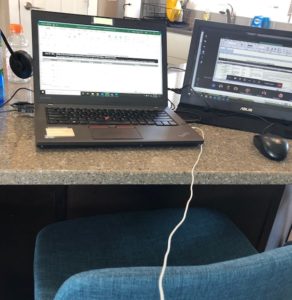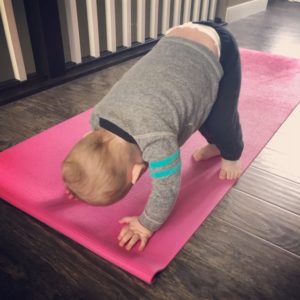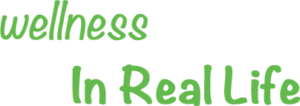“Wherever you are, be there totally.”
It’s an unbelievable time we’re living in, friends. If anyone would have foreshadowed the coronavirus situation we’re in, as a community, as a country, as a global population, I don’t think you’d find one person who’d have ever thought it was even remotely possible.
But here we are, with new COVID-19 changes happening by the day, sometimes by the hour, and life as we’ve known it is no longer the same. It will be again, someday, but not right now and certainly not any time soon.
How COVID-19 Is Affecting Us
My job is in communications so, naturally, I’ve been spending plenty of time watching the news, reading the news, and seeing how our new normal is unfolding on social media. All of this between eating second breakfast, lots of Teams meetings, and, obviously, enjoying the background noise of old episodes of The Office and Seinfeld in the background.
One of the stories that caught my eye last week is that downloads for meditation apps are up significantly within the past couple of weeks. It makes me think that it’s all really starting to catch up with us, take a toll on people – all the social distancing, working from home, and how this type of unprecedented situation has made trying to do our jobs pure madness, at best.

A new normal for many of us – working at home.
I decided this would be a great topic for this month’s opportunity focus: meditation and mindfulness.
Now more than ever, I think it’s in everyone’s best interest to practice some form of daily mindfulness or meditation to keep ourselves sane, focused, and perhaps most importantly, grateful, amidst all the chaos that can too easily bring us down and defeat even the most positive person.
Meditation and Mindfulness
What are we talking about with starting a mediation or mindfulness practice? Let’s begin with, what I believe is the simpler act of the two, mindfulness.
The practice of mindfulness is a bit easier to grasp than meditation, simply because I think the word and concept of meditation in itself freaks people out a bit and conjures up thoughts of long-haired people in white linen pants sitting cross-legged and humming “ohm” over and over.
Yet, to my knowledge, the concept of mindfulness is appealing to most people. The idea of slowing down to speed up, of taking a few pauses during the day to check in, and the discipline of being a bit more self-aware about everything, from positive word choices on your next conference call to whether or not you really want that second breakfast (and if the answer is yes, that’s 100% acceptable. Eat that second breakfast.).
Meditation, on the other hand, is a little more intimidating. However, the concepts really aren’t much different. Both concepts have essentially the same benefits, reducing stress and anxiety among them, are intentional acts, and are about achieving a position of being fully present.
The real difference, as I see it and putting it very simply, is that while mindfulness is meant to be practiced frequently throughout the day, in quick bursts, meditation is a much more focused practice. It really deserves more time and focus to truly clear the mind, get to a state of total awareness, and achieve a sense of calm.
How to Create A Healthy Habit
Before talking about creating either one as a habit, let’s go back to the foundation of this healthy habits series. Like any habit, the desire and a goal along with it are important. Please don’t go into this with anything less than both.
First ask yourself, why do I want to build this healthy habit? Do I really want to or do I feel like I should? Find that purpose, that desire.
If you really want to, the second step is to set your goal and be specific about it. A goal gives you something to measure, something to gauge success, and see where adjustments or improvements could be made.
In this case, you could set a goal to practice mindfulness before every meal. Another goal would be commit to a 15-minute yoga meditation three times a week. Any goal is acceptable and there’s really no “wrong” way to do mindfulness or meditation. Here are a few tips to get started.
First – Mindfulness Basics
Mindfulness is a great healthy habit to adopt. To get started, there are a couple places one can begin.
Figure out times during the day that you could work in mindfulness. One of the best ways to find times for mindfulness is repetitive actions – every time you sit down to eat, every time you get into the car, every time you sit down at your desk, those types of things.
One of the simplest mindful actions is to take a few deep breaths. Pause. Be aware for those moments. Take a moment to slow down, acknowledge, be aware, then act.

One of my favorite meditation practices – yoga.
First – Meditation Basics
Meditation and mindfulness are pretty similar. In fact, some of the same basic points of meditation apply to mindfulness. Simple acts of deep breathing and finding awareness of, everything from that breath to the feeling from your fingertips to your toes.
Meditation requires a bit more dedication, time, and focus, so, again, choose a time to do it regularly that coincides with a routine or perhaps a time of day that’s ultra-stressful and could benefit from calm and focus.
Next – How to Practice Mindfulness
To begin practicing mindfulness, choose that time of day or that regular, repetitive action that lends itself to a brief moment of pause and clarity.
One example is to start the day in a mindful place, beginning with breakfast or coffee. Don’t turn on the TV or look at your phone, instead, take a few deep breaths before taking a bite or sip. Eat and drink slowly, taking time to breath, enjoy the simple pleasure of the food or coffee, and think about how you want to show up today. Gain perspective on challenges you know are going to come your way and what really matters that day.
Another ideal time for mindfulness is when you sit down at your desk. This could be the start of the workday, after going to the bathroom, or returning from a meeting – all opportunities to take a few seconds of deep breaths and focus and get back to the right state of mind.
One of the great things about mindfulness, once the practice begins, it’s easier to incorporate into more activities. It can be done often and while doing other things – yet it’s not the same as multitasking because you’re not trying to do something, rather you’re giving deeper focus and attention to what you’re already doing.
People think I’m crazy, but I don’t use headphones when I run outside – even on three-hour long runs. I use that time for focused, mindful thinking. I gain perspective on challenges in my life. I give gratitude for the health and ability to run (that one comes in handy when I’m fatigued, hurting, or just not feeling it). And, admittedly, I think about food. There are a lot of food thoughts.
Next – How to Practice Meditation
Similar to mindfulness, choosing a consistent time of day is one idea to get started with a meditation practice. Eventually, you might find there are certain times in the day that work better or those where meditation is really needed.
A great way to practice meditation is through yoga. Start the process by just sitting and taking deep breaths, then noticing how you feel through the different poses.
If yoga’s not your thing, skip the poses and just sit quietly, taking deep breaths and getting that deeper sense of being in touch with yourself. That’s really what meditation is all about. The act of doing nothing yet some of the most productive ‘nothing’ there is. Being still, being aware, gaining so much.
Again, these are just basic ideas to get started with mindfulness or meditation. Remember, there’s really no wrong way to practice mindfulness and meditation, as long as it’s serving as a way to find more calm, clarity, focus, and positivity.
Those following along with the monthly wellness opportunities, please share feedback on this one. Additional tips? Opportunities that didn’t work so well? The comments are your space to share thoughts or ask questions so please do so.
In case you missed it, check out January’s healthy habit opportunity: tips to create a gratitude habit and February’s healthy habit opportunity: tips to eat more inclusively.
Connect with me @lindsayinreallife on Instagram or @LindsayIRL on Twitter. Subscribe to Wellness in Real Life so you get every new blog post straight to your inbox.
